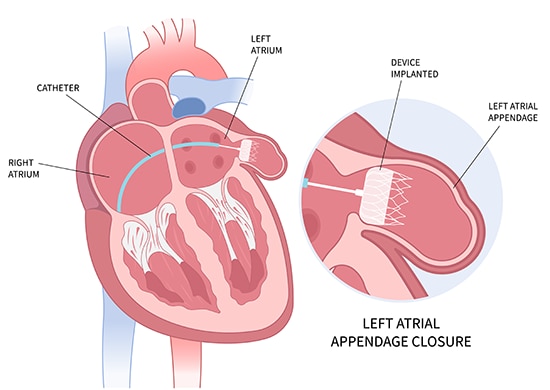Left Atrial Appendage Occlusion (LAAO)
If you have atrial fibrillation (AFib), reduce your stroke risk with a left atrial appendage occlusion (LAAO) procedure at Montage Health. A minimally invasive LAAO implant (such as a Watchman™ or Amulet™ device) may help you stop taking blood thinners.
The connection between AFib and stroke
When you have AFib, your blood doesn’t flow out of your heart chambers the way it should. This makes you five times more likely to have a stroke than the average person. It also means you have an increased risk of blood clots forming in your left atrial appendage (LAA).
Your LAA is a tiny pouch in the upper left chamber of your heart. If blood clots in the LAA escape, they can cause a stroke. Your doctor may recommend a procedure to prevent blood clots from leaving your LAA.
Alternatives to blood thinners
An LAAO procedure is an alternative to taking blood thinner medication to reduce your stroke risk. Blood thinners can help prevent clots, but they also come with:
- Frequent blood tests to check for accurate dosing
- Higher risk of complications during surgery
- Higher risk of serious bleeding
- Inconvenient daily doses
- Increased bleeding from injuries
- Ongoing prescription drug costs
Is LAAO right for you?
Talk to your doctor to determine if LAAO is a good choice to treat your AFib. It may be right for you if:
- You have a job, hobbies, or play sports that put you at risk for serious bleeding
- You’ve experienced bleeding in the past due to blood thinners
- You have difficulty taking blood thinners as prescribed
LAAO procedure benefits
Choose an LAAO procedure at Montage Health to benefit from:
- Less pain, scarring, and a shorter recovery time than traditional surgery
- A less restrictive lifestyle with a decreased risk of bleeding
- Avoiding open heart surgery
- Cost-effective, one-time procedure compared to lifelong medication
- Protection against stroke
What to expect
During the short, minimally invasive procedure, your doctor makes a small incision in your upper thigh and threads a catheter (a thin, flexible tube) into your heart.
Then, using real-time imaging, your doctor guides an umbrella-shaped device about the size of a quarter through the tube and into your LAA.
When the device is in place, it opens to plug the LAA. This permanently closes the LAA to prevent blood clots from escaping. You may need to stay in the hospital overnight after your procedure. The device never needs to be replaced.

Follow-up care
You’ll have follow-up appointments after your procedure to ensure your LAA fully seals. About six months after your procedure, your doctor will also decide how to reduce or stop your blood thinner.